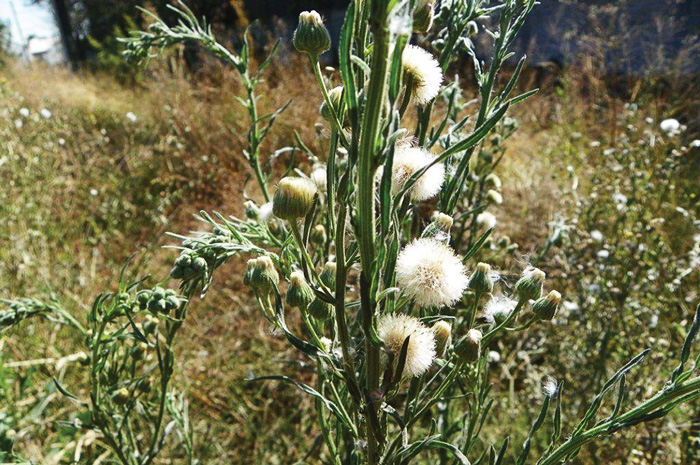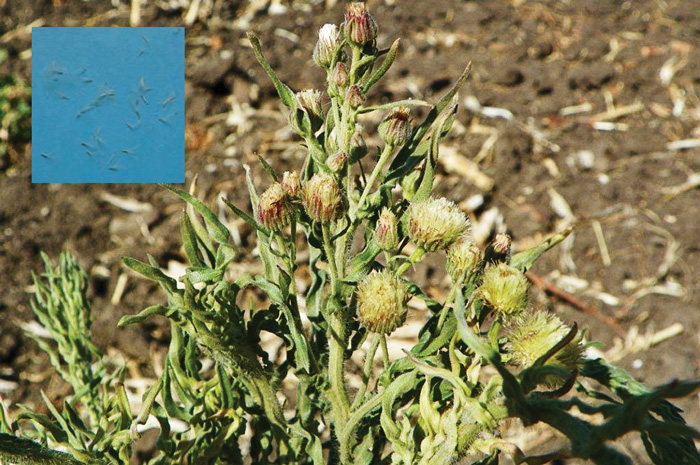Category: WEED SERIES
 |
 |
 |
Typical inflorescence of Conyza spp. |
Seed of Conyza spp. |
 |
 |
Rosette forms of different Conyza spp. |
Rosette forms of different Conyza spp. |
 |
 |
Rosette forms of different Conyza spp. |
Rosette forms of different Conyza spp. |
Scientific name: Conyza spp.
Afrikaans name:
Conyza bonariensis: Kleinskraalhans, armoedskruid
Conyza canadensis: Kanadese skraalhans, armoedskruid
Conyza sumatrensis: Vaalskraalhans
English name:
Conyza bonariensis: Flax-leaf fleabane
Conyza canadensis: Horseweed fleabane, fleabane
Conyza sumatrensis: Tall fleabane
Flax-leaf fleabane can grow up to 1,2 m tall and has side branches that is longer than the main stem. The leaf margins are sharply toothed, but may sometimes be wavy. Both leave surfaces are dull green and hairy. The flowers are white and occur in narrow, terminal plumes on the main stem and side branches. Horseweed fleabane is relatively short in comparison with other Conyza spp., has smaller white flowers and the stems only branch at the top of the plant. The leaves are finely toothed, are more yellowish green and are less hairy. Tall fleabane can grow over 2 m long and does not have side branches that is longer than the main stem. The flowers are also white and occur in large, terminal plumes. The fruits are straw-coloured. All Conyza spp. is semi-woody with sturdy taproots and mostly occur together.
This winter weed is widespread throughout southern Africa. It has small seeds and is a shallow germinator.
Cultivation:
This weed is well controlled through shallow cultivation and is not usually a problem weed in conventional tillage systems. Conyza however, is a serious problem weed in conservation- or no-tillage systems.
Chemical control:
This weed can be controlled with post-(crop)emergence broadleaf herbicides. Pre-(crop)emergence herbicides can also be used before the weed reaches the rosette stage. Several different herbicides are registered for the control of Conyza in wheat (Table 1 and Table 2). The effectivity of herbicides decrease with an increase in weed size and producers must try and control the weed before it shed its seeds. Time of application is of critical importance, but very often producers are not done harvesting before it is the ideal time to spray Conyza. Follow the specific instructions and dosages on every product that will be used for spraying the different Conyza spp.
TABLE 1: Herbicides registered for the control of fleabane on maize.
| Active ingredient | Formulation | Time of application |
|---|---|---|
|
2,4-D/dicamba |
240/80 gram/litre |
Post-emergence of weed and crop, but before crop is 30 cm tall. Apply when the rosette is smaller than 15 cm in diameter and is actively growing |
|
atrazine/sulcotrione |
300/125 gram/litre |
Pre- or post-emergence. When applied post-emergence, an adjuvant must be added |
|
glyphosate* |
500 gram a.i./litre |
Post-emergence, only on glyphosate tolerant maize |
*Some Conyza spp. shows resistance to glyphosate and control is mostly variable
TABLE 2: Herbicides registered on wheat for the control of fleabane.
| Active ingredient | Formulation | Time of application |
|---|---|---|
|
2,4-d/dicamba |
240/80 gram/litre |
Apply between growth stages seven to 13 of the crop |
|
carfentrazone-ethyl |
400 gram/kg |
Apply between growth stages seven to 13 of the crop |
|
dicamba |
700 gram/kg |
Only for use in tank mixtures with Enhancer (10 gram - 12 gram) and Reaper (10 gram) and an adjuvant |
|
metsulfuron-methyl/thifensulfuron-methyl |
68/680 gram/kg |
Before four to five leaf stage of the weed |
|
glyphosate* |
700 gram a.i./kg |
Pre-(crop)emergence |
*Some Conyza spp. shows resistance to glyphosate and control is mostly variable
Contact the writers at elbe.hugo@syngenta.com (Elbe Hugo) and deweth@arc.agric.za (Hestia Nienaber).